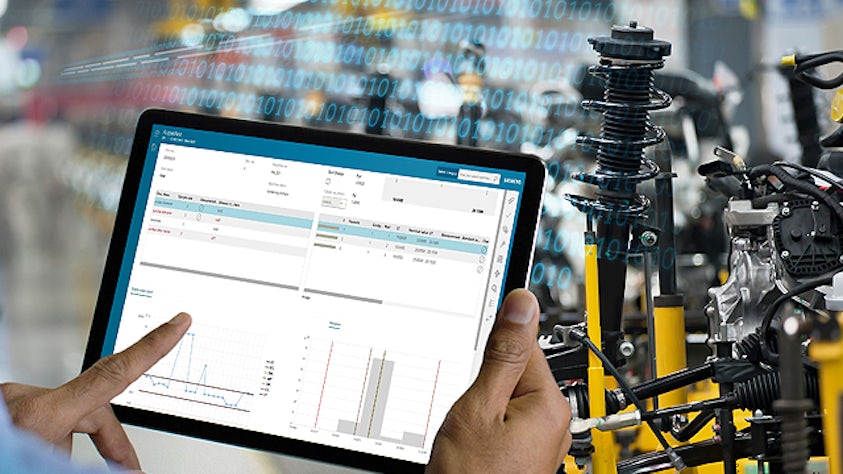Lean production planning and scheduling are sometimes viewed as tools that assist the identification and steady elimination of waste, known by the Japanese term "muda." Each kind of waste can be reduced or eliminated through MOM-based lean manufacturing software.
Defects create waste because of the inspection efforts required to find defects and the corrective actions needed to fix or remove them. With lean manufacturing software, manufacturers can easily search for and contain nonconforming material before defects are formed. Through error-proofing and "right first time" efforts, lean production planning and manufacturing execution software ensure that:
- The right materials are used
- Measurements are within specification
- Operators are properly trained
- Equipment maintenance and calibration are up to date
- Correct procedures are followed
As a result, manufacturers can reduce scrap, defects and rework.
Overproduction generates waste by raising costs associated with work in progress (WIP) and inventory. Through advanced planning and scheduling software, lean manufacturing practices more closely link customer orders and work orders. Lean production planning and scheduling enable better work prioritization and time management through real-time visibility of order status and inventory levels.
Waiting is wasteful because idle time for equipment and personnel reduces productivity and throughput. Lean production planning and scheduling software enable manufacturers to improve the synchronization of operators, material handlers, maintenance, and production steps. Data infrastructure that supports lean manufacturing software provides the means for immediate communication and reduces idle time.
Inventory of materials, components, WIP and finished products wastes space and time devoted to movement and storage, and also raises the likelihood of materials expiring before they can be used. Lean manufacturing minimizes inventory by creating a pull system that limits each operation's queues and enforcing FIFO/LIFO rules. The software provides visibility increasing the accuracy of WIP and finished goods inventories.
Transportation becomes wasteful when materials and documentation are moved unnecessarily or over longer distances. Lean manufacturing software optimizes material movement and eliminates paper documentation so that information travels at digital speeds.
Overprocessing creates waste by multiplying the number of times a WIP or finished good is worked on or handled. Lean manufacturing software reduces overprocessing by eliminating manual data entry and immediately making data and analytical results accessible.
Motion is wasteful when processing involves unnecessary movement of equipment or personnel. Lean manufacturing software eliminates unnecessary movement by:
- Reducing data entry
- Eliminating preparation, handling and review of paperwork
- Automating the distribution of information
- Ensuring materials get directed to the right location
The five principles of lean manufacturing
To implement lean manufacturing, companies typically follow five practices or principles. Lean manufacturing uses this five-step process to create continuous improvement:
- Identify value - Since the primary goal of lean manufacturing is to eliminate anything that does not add value for the end customer, it is important to identify what the customer considers valuable about the finished product. Research of various kinds (such as surveys or interviews) can be used to elicit this information from customers and prospective customers.
- Create a value stream map - The value stream identifies those aspects of the manufacturing process that create the value that the customer has identified. Conversely, any aspect of manufacturing not part of the value stream is wasteful – either necessarily or unnecessarily. Necessary non-value aspects of production often can be reduced in some way (for example, production time consumed or cost). Unnecessary non-value aspects are waste by definition. The goal of lean manufacturing is to eliminate these.
- Generate a process flow - While the value stream map identifies what aspects of a manufacturing process are valuable, a process flow answers the how of the process. It seeks the most efficient ways to advance from raw materials to work in progress (WIP) to finished products. Delays or interruptions create idle time for manufacturing resources. The process flow seeks to eliminate these.
- Establish "pull" (create an on-demand process) - A successful process flow identifies points in the manufacturing process where materials, supplies, WIP or finished products are accumulating. With demand (i.e., customer orders) serving as a primary criterion in a “pull” approach, advanced planning and scheduling systems can optimize the schedule and movement of these things in a way that minimizes inventory without starving any process step of needed resources. This approach embodies the just-in-time principle.
- Continuously improve and perfect - Continuous process improvement entails cycling through the first four steps of this process on an ongoing basis. Manufacturing processes today generate vast amounts of data from sensors, tests and process documentation. As this data is mined for new manufacturing insights, companies are empowered with new information to uncover and eliminate previously undetected sources of waste.



